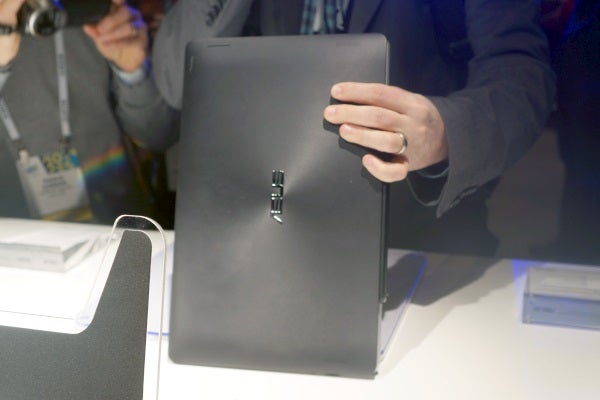Asus Transformer Book Duet TD300 Review
Asus Transformer Book Duet TD300
Hands-on at CES 2014: A tablet-laptop hybrid that runs Android and Windows

Verdict
Key Specifications
- Review Price: £599.00
What is the Asus Transformer Book Duet TD300?
The Asus Transformer Book Duet TD300 is a second go at the concept Asus experimented with in the Asus Transformer Book Trio. It’s a hybrid laptop-tablet that runs two operating systems. Asus calls it the “world’s first” four-in-one to use the latest Intel Haswell generation of chips. It’s an Android tablet, it’s a Windows tablet. But it’s also a Windows and Android tablet to boot.
Watch our hands-on video:
SEE ALSO: Bookmark our daily CES 2014 news update
Asus Transformer Book Duet TD300 – Design and Features
The Transformer Book Duet TD300 is a lot cheaper than the Book Trio it follows on from, starting at $600 in the US. The low price does show a little in the build of this hybrid.
The Duet TD300 looks a little like a MacBook relative from the front, with an aluminium-effect keyboard surround. However, this is a plastic device. It’s only in the tablet part that it becomes a little too obvious. It’s extremely light given its 13.3-inch size, but there is a little flex to its back.
You detach the screen from the base using a button above the keyboard, just like Asus’s other recent Transformer hybrids. 
Asus Transformer Book Duet TD300 – Screen and Specs
The $599 price of the Asus Transformer Book Duet DT300 is eye-catching, especially when the UK pounds figure would hopefully be a little lower. However, the price is heavily dependent on the spec.
Asus will produce the Duet in a wide range of spec options, and what ships to which countries will depend entirely on the demand from retailers. Intel Core i3-i7 processors are all on the list, as well as various storage options.
The biggest difference is in the two different screen types Asus has in the works. There’s a 1,366 x 758 TN panel and a 1080p IPS display used in different iterations of the Asus Transformer Book Duet DT300. One is much sharper than the other, but as a tablet hybrid, using a TN panel is a serious issue.
TN screen panels universally suffer from contrast shift (to some degree), which causes clouding of the screen image when it’s held at certain angles. And, you guessed it, the price quoted by Asus involves using the lower-resolution TN screen. The Asus Transformer Book Duet DT300 as it’s meant to be will cost a bit more. 
Asus Transformer Book Duet TD300 – Software
The form-converting hinge is only half of the reason why the Asus Transformer Book Duet TD300 is such a flexible gadget. Software also has a huge part to play.
The hybrid runs both Android and Windows 8.1, and both run off the Intel Core processor. This is completely different from the previous Book Trio, which had two separate processor units, one for the Android tablet and another brain for the Windows laptop machine.
Serious work has gone into making Android run on Intel’s processors (natively, rather than through emulation), and we didn’t notice any game-ending performance issues during our time with the Asus Transformer Book Duet TD300. There are likely to be some app/game compatibility niggles, though.
Asus claims 99 per cent of Android apps will run on the Asus Transformer Book Duet TD300, but we did notice that Gameloft’s Asphalt 8 did not run at the tablet’s native Full HD resolution. It would have looked a lot better on a ‘normal’ Android tablet. However, some of this may be on the app developer’s side.
To switch between the operating systems, you use a dedicated button on the keyboard, or another button on the bottom edge of the tablet part, when it’s detached from the keyboard base. The switch over takes around four seconds, and seemed to work almost eerily well given the dramatic shift it is technically. This isn’t running a different app. It’s running a different OS.

Early Impressions
There are a few awkward parts to the Asus Transformer Book Duet TD300. Its headline price doesn’t reflect the version of the product we’d want to own, and even at its full spec it won’t feel as impressive as an aluminium or magnesium Ultrabook.
However, the ease with which the TD300 switches between Android and Windows is impressive. And while many will dismiss this as a solution to a non-existent problem, the idea of being able to take off your laptop’s screen to watch or play on the sofa or in bed isn’t a bad one.
Next, read our best tablets round-up
How we test tablets
We test every tablet we review thoroughly. We use industry standard tests to compare features properly and we use the tablet as our main device over the review period. We’ll always tell you what we find and we never, ever, accept money to review a product.


